Photographing Salamanders
By Richard D. Bartlett
One of my greatest pleasures in life is photographing wildlife. I particularly enjoy photographing the smaller reptiles and amphibians, salamanders and newts included. When approached about doing this article, I explained that I was a dinosaur, still using only 35mm film and a single lens reflex (SLR) camera (a Canon EOS), and that I had no idea at all of how my approach would or could be adapted to the growing host of photographers who use the ever-improving digital technology. With that said, I’ll leave the adaptation from film to digital to you, and simply relate a few of the “tricks of the trade” that have helped me with traditional photography. Please bear in mind that this is not intended to be a technical article. You can find those in any photography magazine.
Unlike digital cameras, SLRs do not have low-light enhancement capabilities. The ambient light must either be adequate (read that bright) or it must be augmented by illumination from a flash unit. The lower the ISO of your film, the more light is required by your camera. The higher the reading of your F-stop (the aperture gets smaller as the numbers increase) the more light your camera will require. The darker your subject, the more light you will need, and if you take pix through even very clear aquarium glass and very clean water, you will need more light yet.
So we’re already talking light, light, and more light. How does a photographer go about providing sufficient light, insuring against reflection, posing a subject, and taking into account all other variables?
Your film: prints vs slides, and ISO: Let’s start with the last item first. The acronym “ISO” stands for International Standards Organization and will, alone, mean little to you. It is the number following the acronym that is important. The number indicates the “speed” (the sensitivity to light) of the film. The higher the number, the more light-sensitive the film. Thus, a film speed of 200, 400, or even greater, is more useful to most amateur photographers on a cloudy day or indoors than a film having a speed of ISO 50. As a generalization, the higher the film speed the grainier the film (although film is getting better all of the time). But with that said, if you are taking pictures simply for your own viewing pleasure, using a film with an ISO of 200, 400, or even greater, will probably be entirely satisfactory, especially if you are viewing the results on small prints (4x6 or 5x7 inches-- prints of this size are easily kept in an album, and are certainly large enough to be viewed). When a print is blown up to poster size, the graininess of high-speed film may become apparent.
Slides, of course, allow you to project images for presentations and can be enjoyed by hundreds of folks simultaneously. The suffix of “chrome” or “color” will tell you what medium you are using. Chrome (as in Fujichrome or Kodachrome) indicates slides, while color (Fujicolor or Kodacolor) indicates prints. The comments regarding graininess hold equally true whether your film is for prints or slides. Because I use my slides for presentations and graininess can be an issue, I use a low ISO (my preferred film is Fuji Velvia with a light sensitivity value of ISO 50).
If on a photo shoot, be sure you have plenty of film and replacement batteries for both your camera and your flash unit.
Your camera: That I am even more of a dinosaur than I initially admitted is shown by the fact that, although I have a camera and lenses that “think for me”, I preclude them by using manual settings. I do this mostly because I’ve always done it that way, and because I like to think that I can actually “out-think” the camera. It’s encouraging to know that I succeed (at least most of the time). I allow my flash unit somewhat freer rein, keeping it on ETTL (through the lens) mode, but programming in an extra half stop of illumination. Because of today’s electronics, a camera body can be expensive, but it is still essentially a black box that keeps unwanted light from getting to your film. Today, you, often in combination with the electronics, command the black box when, where, and how much light will reach your film and for how long. There are many automated settings - F-stop priority, macro-settings, and averaging (shutter priority) amongst them - on today’s cameras, but I have found none as dependable for macro work as the manual setting.
A typical setting for me when photographing a salamander on moss is manual at F-16, with a 100-mm macro lens, and the flash unit set to a compensation of +1/2 F-stop in the ETTL mode. If the salamander is black (such as a slimy salamander) and the background is also dark, or if I am taking a photograph of a newt in a fairly dark aquarium, I will set the flash unit to a compensation of +1 full F-stop in the ETTL mode.
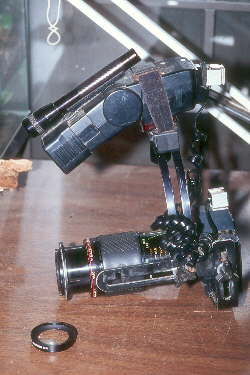
The camera setup includes a 100-mm macro lens, a flash-bracket, and a powerful flash-unit. With such a setup, the closeup attachment shown next to the camera is not needed.
Your flash unit: Most of today’s cameras have a built-in flash unit that can be used when necessary. However, in many cases - not because of its strength, but because of its position - this flash will be inadequate for close up work. Pure and simple, if you are using a macro and taking extreme close-ups, the camera’s built in flash unit will overshoot the subject.
An articulated, off-camera flash held in place on a sturdy bracket is the best solution to this potential problem. The articulation of the flash unit allows the best aiming of the flash. The flash derives its power from a power cord made specifically for the purpose. Even though flash units are expensive, it is best to get the most powerful unit possible that is dedicated to your camera.
“Dedicated,” you ask? “What’s that?” Well not all camera accessories are born equal. Nikon talks and interacts electronically with Nikon brand accessories and Canon with Canon. Most of the other major brands interact only with their very own brand name accessories. It is possible to have accessories of some brands adapted to fit a camera of another brand, but ascertain that whatever you are buying is completely compatible with your camera before purchase. The accessory not only has to fit, it also has to be able to correctly interpret the commands sent to it by your camera.
Most flash units no longer show the F-stops to help you ascertain a correct flash intensity. Rather, they have modes such as ETTL (through the lens), M (manual), and plus or minus intensities. Read your manual carefully, experiment a little, then read the manual again. The plus or minus intensities (usually in half or third F-stop increments) will be important for you if photographing a dark salamander against a dark background, when compensating for a very light background, of if you happen to be photographing through water. Experimentation is the key to success here.
Nighttime photography, even in the darkness of an urban swamp or woodland, can be made easy by placing a small flashlight (a 2-cell AA-size Maglite works well) atop the flash and holding it in place with Velcro. The light from the flashlight beam will allow you to focus with your hands fully free to manipulate the camera settings. It is not necessary to turn your flashlight off during flash photography. The strobe from your flash unit will overwhelm the beam from the flashlight.
I have found ETTL with a +1/2 to a +1 compensatory setting to be the best for my work.
Your F-stop and depth of field: Depth of field is directly related to F-stop settings. The results of any given combination are particularly obvious when you are working close-up in macro mode. The F-stop regulates the amount of light that reaches the film when you press your shutter release. It works in reverse of what most beginners would expect, with the lowest numbers (i.e. 1.4 or 2.8) allowing the most light and the highest numbers (F16 or F22) permitting the least. There is no need to delve into this in great detail here, but it is necessary to mention that the higher the number (F16, F22) the greater your depth of field. It should be also mentioned that the depth of field increases as you back away from your subject, no matter the F-stop. Read your camera-operating instructions and experiment until you are comfortable with the results. Always use the smallest aperture (highest F-stop number) possible for close ups.
Your lenses: Although the standard 50-mm lens that normally comes with your camera body will allow you to take wonderful habitat pictures, it will be of no value to you for photographing the salamanders themselves. A 50-mm lens can be made more useful by using close-up lenses (1X, 2X, and 4X) alone or in series. However, close-up lenses can be difficult to work with, and each one will reduce the available light. To do justice to your salamander subject, a macro lens is a necessity. For most cameras, these are not standard lenses, and they differ from close-up lenses in many ways. Macros are designed for close-up work and require no additional attachments. They are more versatile than close-ups, especially with a living and possibly moving salamander.
Many very successful photographers use a 50-mm macro lens, but I recommend a 100-mm macro lens. Any rated greater than 100 mm are much more expensive and are not needed for salamander photography. A 100-mm macro lens will allow you to diversify into the photographing of subjects more dangerous than salamanders (such as venomous snakes) safely.
Most of today’s lenses have both an auto-focus and a manual mode. I have found autofocus to be a great help when I’m photographing a flying bird, but and equally great hindrance when I am doing macro work. Autofocus also draws heavily on your camera’s battery. I prefer to use the manual focusing mode.
Background: How you intend to use your photos and what is pleasant to you should figure prominently in the background(s) against which you photograph your salamanders. Patience is a virtue for any photographer. I have a large aquarium (200 gallons; 800 liters) in which I keep newts, mudpuppies, and sirens of various species and compatible sizes. I often sit for very long periods, camera poised, hoping for a photo opportunity. The caudates crawl and swim under, between, and over a substrate of naturally-colored river rock and waterlogged sycamore and sweet gum leaves. Once in a while just the right pose is assumed while I’m there waiting, and I wind up with a pleasing photograph. But naturalistic photos often show only one surface of the newt well. For example, although the brown sides and back of a warty newt is easily photographed, I have to work a bit harder and wait until it clambers among the leaves of aquarium plants before I get a chance to photograph its red-reticulated belly.
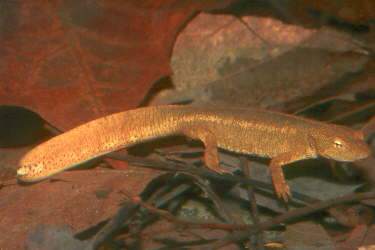
A spotted-tailed warty newt rests against a background of leaves in a large aquarium.
Many salamanders are found foraging at night in mossy, forested areas. We, as naturalists, see these habitats as areas of unparalleled beauty and invariably acknowledge that the salamander looks completely at home. Yet when we place a salamander on moss to photograph it, the moss may obliterate some of the key characteristics (such as leg length and toe number) that you are trying to show. Also, although the salamander may look fine in the viewfinder, the end result on film may be less satisfying. Cameras (including digital formats) often have difficulty producing a satisfying image of a very light salamander on a very dark background, or vice versa. A dusky salamander or a brook salamander often looks best against a background of wet sandy mud, a red salamander against a background of dead leaves. Taking a salamander’s picture against either white or colored aquarium gravels usually does not produce satisfying results and multi-hued river-rock substrates (especially those consisting of black and white stones) are equally unsatisfying. Again, experimentation with different backgrounds will be necessary in order to learn the parameters of your camera and your own preferences. I use gravel that is small (about pea-size) smooth river-rock of natural color.
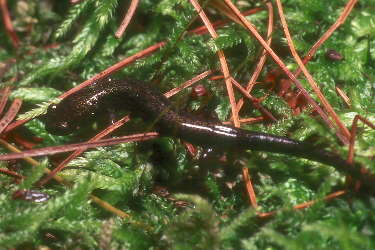
Although found on moss, the legs and feet of this ravine salamander are hidden. The depiction would be better if the salamander had been photographed on a dead leaf or piece of log.
I have found that many salamanders appear best on film when the background is plain, but of a pleasing color. A single large, green leaf with a matte (rather than a shiny) surface, a piece of pine bark with some tiny fungi or lichens behind the salamander, or a weathered brown leaf (such as from a sycamore) can be a perfect background for macro work. But keep in mind that your camera does not always “see” things like the naked eye. A background of a shiny yellow leaf may look fine to you but may bleach the entire picture. Some of the most horrid pictures I’ve ever taken were of a beautiful little red eft sitting quietly on an equally stunning freshly fallen red sugar maple leaf in a hemlock copse. On film, what had seemed natural and vibrant to my eye, proved to be so color saturated that it was absolute overkill!
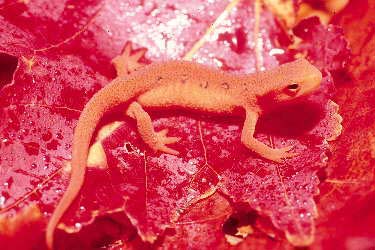
Red on red equals overkill. This red-spotted newt eft was more peasantly depicted on a background of short green moss.
Aquarium photography: Some helpful hints
- Flash: keep your flash unit on the camera or bracket, as always.
- Back-lighting: Although sunlight coming through a window into the back of an aquarium may increase the ambient lighting, allowing you to use a smaller aperture, it is also very apt to overpower even the strongest flash-unit, rendering the images of your salamanders little more than black marks on the film. Normal, over-tank aquarium lights are not a problem.
- Reflections: a concern or not? There is no easy answer to this question. Some reflections are problematic and others are not. Unless they are very, very intense, reflections from room lighting in the glass of an aquarium will be of no concern. Your flash will simply overpower them. It is the reflections caused by the flashing of your flash-unit, itself, that will be most problematic. To overcome the most serious cause of reflection, think of your aquarium glass as a partial mirror. If your flash enters from straight on (or almost straight on), the reflection back into your cameral lens (hence recorded on the film) will be overwhelming. However, if you angle the flash unit, the emitted light will strike the glass and reflect off at an angle that will miss your lens entirely. I try to take all aquarium shots at about a 30-degree angle, waiting until the newt or salamander is also angled similarly, before actually taking the photo. Aquarium frames, shiny table-tops, and nearby glass and mirrors can also produce reflections. When taking pictures in an aquarium, keep the aquarium in an open, non-cluttered area. Position the tank at the very edge of the table or stand on which it is sitting, or place a non-reflective black velvet over the exposed edge of the table in front of the tank. Similarly, black velvet may be used to obliterate reflection from any other shiny surface.
- F-stop compensation: Transparent though it may seem, the glass of the aquarium and the water will absorb some of the light output from your flash unit. Add in a compensatory 1 to 2 F-stops of light. Experiment.
- Take your picture. If it is not what you hoped for, adjust the above parameters accordingly.
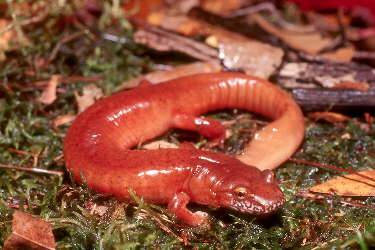
This Blue Ridge spring salamander was found beneath a piece of bark in the Smoky Mountains and photographed in situ.
Posing your subject: Always wash and rinse your hands thoroughly before (for the salamander’s safety) and after (for your safety) handling any salamander. Because salamanders absorb topical insecticides, hand-lotions, medications, and other materials through their moist skin, impurities can be almost immediately debilitating or fatal to the little creatures. Salamanders are, for the most part, creatures of cool, clean, moist (or wet), habitats; they will often react adversely to the heat of your hand. It is often not necessary to handle these amphibians to pose them for photographs. Learn alternate techniques for posing salamanders. Rather than touching them with your finger, use a clean plastic stick to gently alter the position of a leg, the tilt of the head, or the curve of the tail. Plastic coffee stirrers from McDonald’s are ideal - no salamander photographer should ever leave home without several. Nor should a natural history photographer ever begin a photo session without ample patience. With patience and a stir-stick (and a properly appointed camera, of course) wonderful photos can be had.
When posing your subject, both composition and depth of field must be considered. Those of you who know salamanders and even a little about photography will know that, for the most part, a salamander positioned in a straight line from nose to tail tip will look like a slender dark line in your frame. You are not likely to be satisfied with the results. You will also learn that when you are taking macro-shots (at F-16 or F-22) you have about an inch (2 cm) depth of field in which everything will be in perfect focus. With that in mind, then, if you take a picture of a 6-inch (15-cm) salamander heading straight for the camera, only the first inch or so of the animal will be in focus. The remaining length will be blurred. Whether you like this or not will depend on your perspective. Sometimes, as long as the eyes are in perfect focus, a soft image can be pleasing. Take overview pictures both from the side and from above and also take close-ups of the head from both angles.
I have found that carefully inducing a salamander to assume an open S is an ideal position in which to photograph the creature. This can often be done by gently touching the creature’s nose with the stir-stick, causing it to back up a bit. The tail may also need to be positioned, curling it gently forward with the tip of the stir-stick. Once the salamander is quiet, take the picture from the side with the snout either lateral to, or the nose pointing slightly toward the camera. Focus on the nearest eye. Select your F-stop, take a picture (or 10) and then bracket (open your F-stop up one half setting then a full setting, then down in the same manner), taking pictures in all alternate settings.
While they are sitting quietly, salamanders often keep their snouts pressed tightly against the substrate. A better photo may be had if, with the flattened tip of the stir-stick, you gently lift the salamander’s nose. It may be necessary to reposition the salamander several times to accomplish your goal, and this is where the stir-stick and patience are so beneficial.
Whether or not the images taken are precisely what you had hoped for, each photography session should be a learning experience that will help you approach the next attempt with more confidence. With time you will have the equations solved, and will be competing in the next photo contest.
© 2004 Richard D. Bartlett
